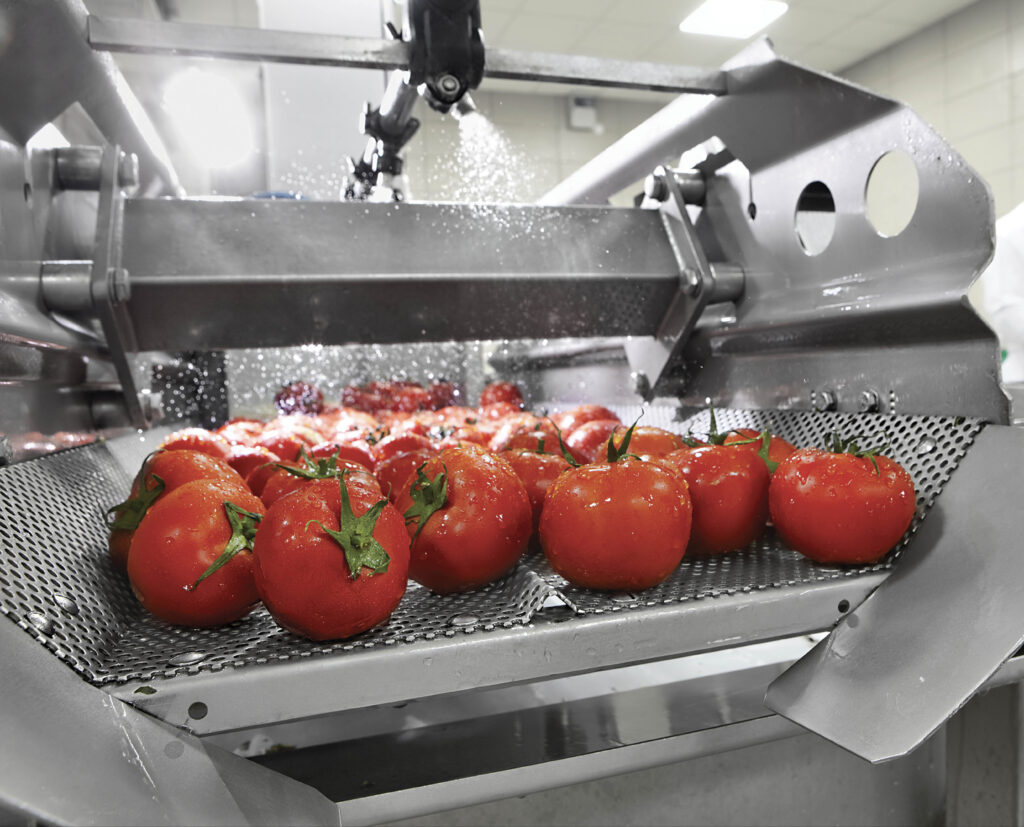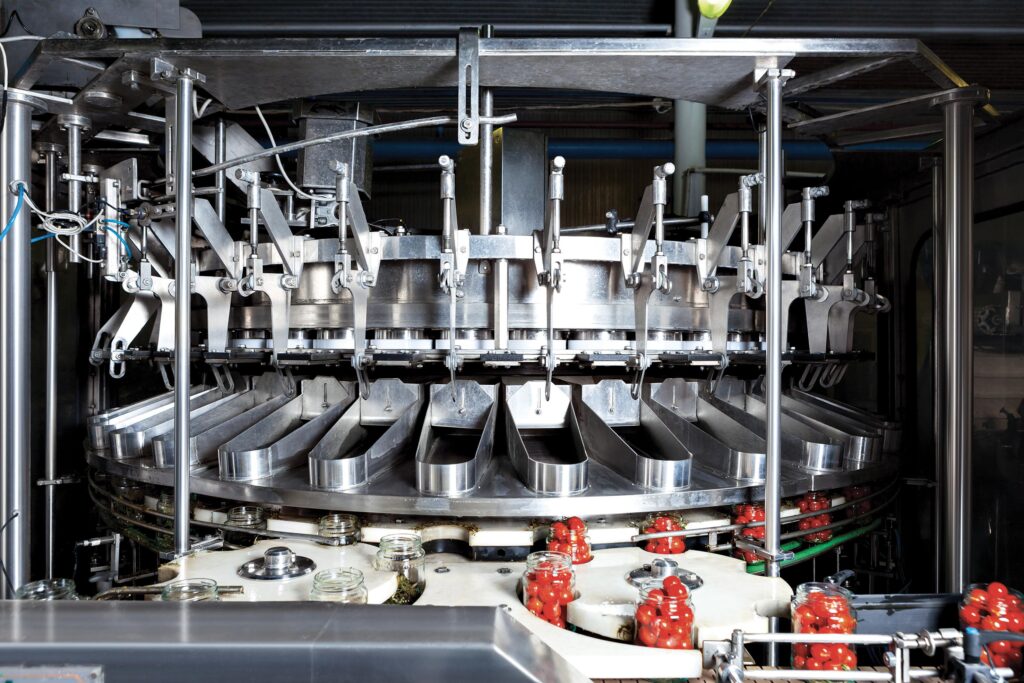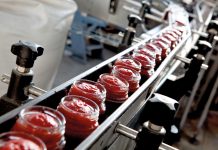 Canned tomato sauce is a fundamental “pantry asset” for Italian families. Major brands are investing in R&D, and innovating plants and processes in the name of sustainability and waste reduction, expanding their product range, developing new packages and formats with a high service content.
Canned tomato sauce is a fundamental “pantry asset” for Italian families. Major brands are investing in R&D, and innovating plants and processes in the name of sustainability and waste reduction, expanding their product range, developing new packages and formats with a high service content.
In Italy, more than 300 varieties of tomatoes are used, and in 2022 processing reached 5.5 million tons, 10% less than in 2021; even the hectares cultivated have decreased (- 8.5% compared to the previous year). The companies belonging to the Italian Association of Plant Food Canning Industry process 70% of the tomato preserves produced in Italy.
The Tomato
Tomato is a berry composed of juice and pulp (95%), peel (1-2%), and seeds (2-3%). The composition of the berry is influenced by cultivar, cultivation method and climate. The characteristics that are most relevant to the canning industry are the size, the shape, the colour of the berries, the total solids comprising all the components of the product , except for water and volatile compounds.
Total solids include soluble and insoluble solids. The former include glucose, fructose, small amounts of sucrose, organic acids, fats, mineral salts, pigments. The latter include proteins, cellulose, pectins and polysaccharides. The green colour of unripe tomatoes is due to chlorophyll, while the colour of ripe tomatoes derives from carotenoids (lycopene, β-carotene). Other important micro-nutrients are ascorbic acid (vitamin C), vitamin E, phenolic compounds, flavonoids, potassium, iron, phosphorus, and B vitamins.
The Commercial Classification
Tomatoes may be classified into the following commercial types: Table tomatoes and processing tomatoes (for the preparation of concentrates, peeled tomatoes, juices), and the so-called “pomodori da serbo”, tomatoes for storing (cultivated mainly in Southern Italy and Spain, i.e. whole tomatoes preserved in cool rooms and in half-shade, for use in the winter).
The canning industry packages purées, juices, and sauces in glass containers and whole or peeled tomatoes, in pulp or cubes, in tin-plate cans, whose interior is provided with a coating that protects the can from interactions with the contents. Tomato varieties with oblong berries and firm pulp, a high content of cellulose and pectin,are preferred for industrial processing, as these properties help to maintain the product texture even after processing. The peel should come off easily from the pulp. For the peel-off process traditional techniques or new technologies can be used, to make production processes more efficient and reduce their environmental impact.

Coatings
To meet technical and legal requirements, can coatings must withstand production and sterilization processes, be usable with all types of food, prevent migration in quantities that endanger the health of the consumer, adhere to metal even in the event of accidental deformations, resist aggressive foods, and retain their organoleptic properties for several years. A group of researchers has recently developed a coating based on by-products of tomato processing (seeds, peels and pips). The material seems to have the characteristics to be able to establish itself as a substitute for the current synthetic coatings.
The Flowchart
It is useful to assume that the whole handling of tomatoes, from harvesting to packaging, is set up to avoid damaging the produce. The tomatoes are mechanically harvested and delivered to the processing plants in plastic bins. Upon arrival at the plant, the bins are weighed and sampled to verify the compliance with agreed quality standards. The compliant product is identified by the batch number and is stored awaiting processing. The bins are then transferred to an automatic lifter-tipper that empties the tomatoes into a tub, where the detachment of soil residues from their surface is carried out.
The bottom of the tub is equipped with pipes that blow air into the water, creating a stream that pushes the tomatoes toward the immersion drum and then toward a perforated extraction mesh belt, for a first dripping. The shape of the tank bottom ensures the drainage of sediments, which are directed to the drain valve. Some lines are equipped with brushwood removal mats, where the tomato is rinsed with water jets to mechanically remove any residual stubble and unsuitable tomatoes. The perfectly washed and intact tomatoes are then carried to a second washing tub, to continue the removal of foreign bodies, unsuitable parts and other earthy residues.
Clean tomatoes are then unloaded onto a conveyor belt and carried to an optical sorter, where unripe tomatoes or those with necrotic parts are discarded. After this, the tomatoes are peeled with traditional techniques or with new technologies that work with a view to improving efficiency and reducing environmental impact. The tomatoes coming out of the peeler are again sorted and checked on lines that combine the experience of operators with the functionality of optical sorters; they inspect the outside of the berry to detect discoloured or damaged parts, and its inside, to detect small defects up to the size of a millimetre. Some plants are also equipped with metal detectors and X-ray systems.
The ready-to-eat tomato is then cut and transferred to the volumetric filler that automatically fills the metal cans until the pre-set drained net weight is reached. The cans, still without a lid, are transferred to a machine called “Colmatrice”, which injects juice under vacuum at approx. 90°C , until the pre-set total weight is reached. Finally, the cans are sent to the seamer for their closure. Lidded cans are then sent to the pasteurisation, cooling and drying tunnels; at their exit, the cans are coded by means of an ink-jet printing system for traceability, and re-traceability of products, labelled, grouped in clusters, on trays or bundles, depending on their size.
Multi-packs are palletised on wooden pallets and sent to the logistics system. At each work step, samples are taken for laboratory checks. Additional automatic controls are carried out on the entire production. X-ray scanners and other systems are used to detect foreign objects, and to discard swollen cans, cans with inadequate vacuum, or incorrectly crimped cans.
Skin removal
One of the most delicate steps in the process described above is peeling. The company needs to strike the right balance between proper peel removal, maximum waste reduction with minimum nutrient loss. It is equally important to minimize the consumption of water, energy, and process chemicals, as well as downtime, labour and process costs in general; even the costs of raw material waste management and wastewater treatment must be reduced, if a chemical method is used. Conventional peeling techniques use mechanical systems, hot water, steam, lye, whereas new technologies use infra-red, ohmic heating, ultrasound or enzymes.

Traditional Peeling Techniques
Mechanical peeling takes place dry, at room temperature and can be non-abrasive or abrasive. The first is a real cut of the skin with a sharp blade, where all residues are then removed with water. It is an inexpensive, environmentally friendly technique, used on lines that are not very fast, and the waste can be as much as 30% of the initial raw material.
In abrasive mechanical peeling, hard brushes or abrasive rollers are used, which work by applying the shear force to the skin-to-flesh interface. The two techniques are often integrated with each other, the tomatoes are processed sequentially by abrasive devices and blades with controlled speed and depth, to obtain a finished product with a very clean surface. The blades and abrasive elements are often tailored to the shape and thickness of the skin to be removed and its adhesion to the flesh.
Lye peeling is used for tomatoes with thin skin. The berries are immersed in a solution of sodium hydroxide or potassium hydroxide with a concentration ranging from 8% to 25%, at 60°C to 100°C for a maximum of 30 seconds. The solution penetrates the peel where it dissolves the pectins and hemicellulose; the weakened peel is detached from the pulp.
Any residue is removed using high-pressure water jets or the abrasive peeling technique. A good alternative is dry lye peeling, where the caustic solution is sprayed onto the product in a high temperature environment. Both techniques are very popular because their process parameters (time, temperature and solution concentration) are easily controllable and adjustable. When not perfectly managed, they can cause cell damage and discolouration of the surface layer of the pulp. Another aspect to bear in mind is the obligation to proper wastewater treatment to bring the pH of the wastewater back to an acceptable range.
Steam peeling involves placing the raw tomato in a pressure vessel, where it is exposed to high temperature and pressurized steam for no more than 30 seconds. Returning to atmospheric pressure, thermodynamic changes on the surface of the product will cause the skin to peel off. Any residue is removed using a hot-water jet or with mechanical peeling techniques. It is a very reliable technique, having the care not to cause excessive softening of the product. To overcome this inconvenience, some resort to rapid product cooling immediately after peeling.
In thermal peeling the products are carried through a tunnel equipped with gas burners, where a flame burns the skin surface for no more than 3 seconds. The main advantages of this method are the reduction of microbial populations and the preservation of the ascorbic acid concentration of in the product. Building and operating the plant is more expensive than previous solutions.
New Peeling Technologies
Emerging technologies include infra-red radiation heating, ohmic heating and ultrasound-assist peeling methods and enzymatic peeling.
Infra-red peeling is a chemical-free process at high temperatures, where the rapid heating of the surface of the product, up to one millimetre thick, is achieved with non-ionizing radiation from far and mid-infra-red wavelengths; the treatment weakens the skin to the point where it can be easily removed with water. The tomato pulp does not exceed 30°C and its nutritional and organoleptic characteristics remain intact. By interacting only with the skin, this process ensures minimal waste of raw material, better product integrity and firmer texture than steam-peeled tomatoes. By not using chemicals, the skins can be reused in feed or as food ingredients and the costs of wastewater treatment decrease.
Ohmic heating peeling has been developed specifically for the tomato industry; it is obtained by electro-heating the surface of the product controlling the electrical conductivity of the peeling solution. The tomato is immersed in a solution of sodium chloride or sodium hydroxide where it acts as an electrical resistor, and generates heat when electricity passes through it; the dissipation of electrical energy into heat quickly and evenly heats the surface of the tomato. The combination of lye and ohmic peeling improves the quality of peeled tomatoes, reduces wastes as well as water treatment costs, as the process is very efficient.
Ultrasound peeling uses low frequency ultrasound (20-100 kHz) to treat tomatoes soaked in warm water; the cavitation caused by ultrasound removes the skin from the pulp. The synergy between ultrasound and hot water results in good peeling quality. This method has been developed to replace lye peeling.
Enzymatic peeling uses hydrolytic enzymes (pectinase, hemicellulase and cellulase), infusing them into the skin surface which weakens due to degradation of the pectin matrix and the rupture of the hemicellulose-cellulose lattice in the epidermal and hypodermic layers of the fruit.



